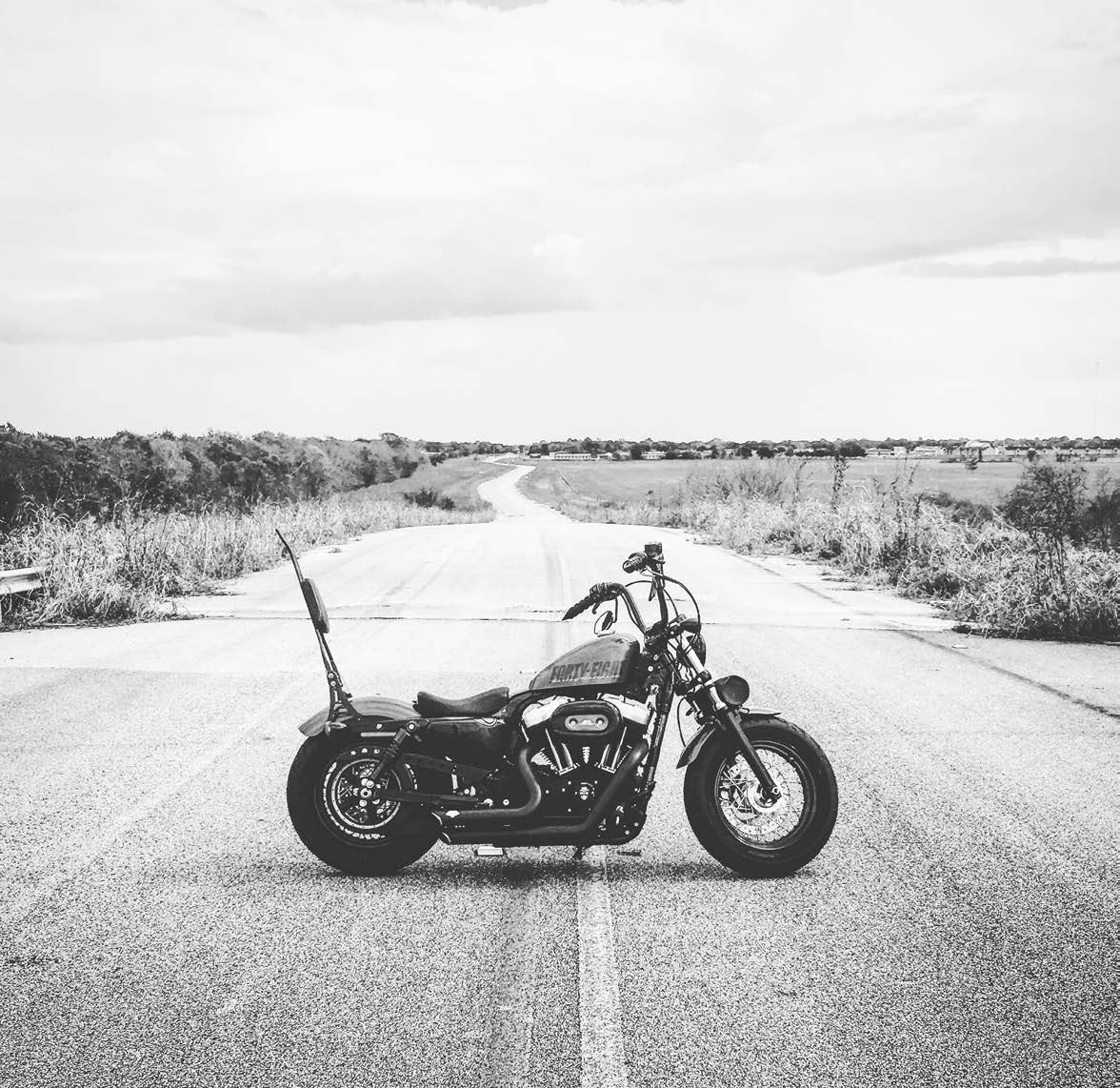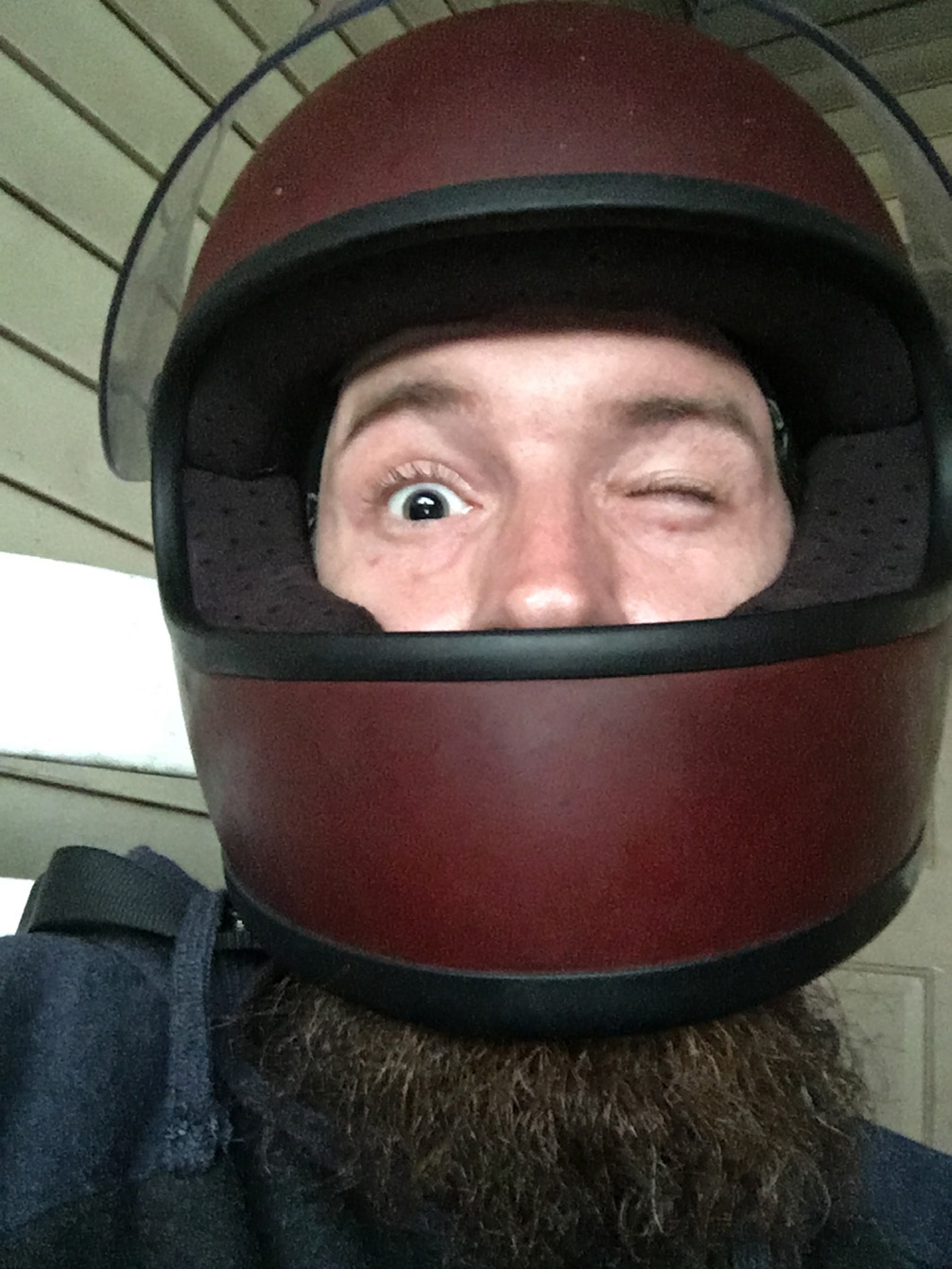
Clinton’s Harley 48 Sportster 1200cc on an abandoned road in Bay City, TX. Photograph by Clint Kuss.
Have you ever been apart of something that was much bigger than yourself or had a feeling so insatiable that you were hooked instantly–a sensation unmatched and unique to its self and unique to the individual? I think I am addicted. At least, I would compare it to an addiction, driving a motorcycle, trying to satisfy that itch you cannot scratch. When it comes to riding, there is a distinct sense of freedom, liberation, but with great risk comes a severe responsibility. Words will be pressed to give the feeling of riding justice. The smell of gas and passing road kill, the constant comforting vibrations, and the ever present looming threat of the infamous “texter” are but a couple parts of the hybrid colectif that is riding a motorcycle. It is one of those things you have to experience and even with my own close calls, fast runs, long rides, and spills; I am still not sure I could match the feeling with spoken word.
I make a choice every time I strap that flat burgundy helmet on and mount that gunmetal grey steel horse. One is to be in the balance, sure and unsure simultaneously. As for now, this hunk of metal is all I have. Rain or shine, I ride. Any road can be taken on two wheels: gate, no gate, pavement, gravel, dirt, and even the ones that don’t much look like roads anymore, those lost and forgotten throughways. The abandoned back roads that lead nowhere. But then again, isn’t “nowhere” just a matter or perception? Here is something to remember…getting lost is just a part of it.
Being a part of this biker community is more than just owning a motorcycle; it is a mentality, a lifestyle, and for not only me but also many others that chose to “chase the dragon,” it is a savior. I don’ t know if it is the danger element or the responsible disregard of said danger, but when I ride, its faster and harder each time. I am always pushing the boundaries and the bike is consistently instilling a fervent sense of courage and self worth in me. “Death is always on the mind and never too far behind.” For me, riding is a time I can think; I mean truly think. My ears honed in on the engine roar and the dashed directing white lines have become one solid blur. A time when the trees go by so fast they seem to standstill and serene. Maybe it is the chaos that allows a scrambled mind to align itself.
Jon Paul Burbank: It’s a passion that you feel through every part of your body, in every vein that runs under your skin. It’s just something you can’t get away from once your there. It’s like a drug…you get hooked. That’s the best way I can explain it. Everyone has their own vice: cigarettes, alcohol, weed. Motorcycles are the same way. Riding relieves the stress. It’s damn near therapy. It’s a way to get away from the problems of life.
Most cats that we ride with are average everyday people like myself: mechanics, military vets, animal vets, construction workers, you name it. I myself am a working musician, chef, and full time student. Both my Uncle Richard, a construction worker himself, and Uncle Ed, a boat captain here on the Mississippi, have been riding motorcycles for as long as I can remember. I used see them pulling up under the carport on their Harleys like the knights and cowboys of some distant dreamland. And there I was, that young boy saying, “That’s going to be me one day.” The fact that people from all walks of life find a haven in this community and are willing to work together without a notion of profit other than the fulfillment of seeing a friend up and riding again is incredibly uplifting. But the omnipresent helping hand extends much farther than simple mechanics and pep talks.

Self-portrait by Clinton Kuss.
 NOLAbeings Multimedia artist Claire Bangser created NOLAbeings as a portrait-based story project that marries...
NOLAbeings Multimedia artist Claire Bangser created NOLAbeings as a portrait-based story project that marries...  Voodoo in New Orleans: Reviving history: New Orleans fortune telling This article takes a deep dive into the history of Voodoo in New Orleans, its hybridization with Catholicism, and its present-day place in the city's culture. The author visits fortune-tellers in the French Quarter, using their guidance as a tool for introspection rather than a deterministic predictor of the future. Through her experiences in New Orleans, the author feels a mystical connection to both the past and the future.
Voodoo in New Orleans: Reviving history: New Orleans fortune telling This article takes a deep dive into the history of Voodoo in New Orleans, its hybridization with Catholicism, and its present-day place in the city's culture. The author visits fortune-tellers in the French Quarter, using their guidance as a tool for introspection rather than a deterministic predictor of the future. Through her experiences in New Orleans, the author feels a mystical connection to both the past and the future. 